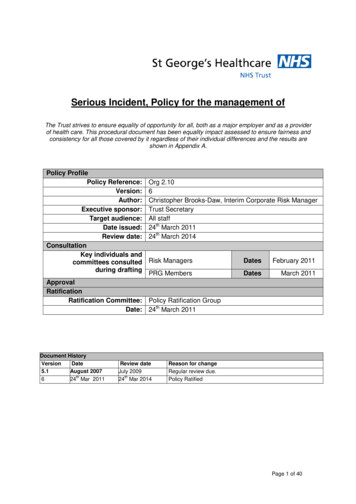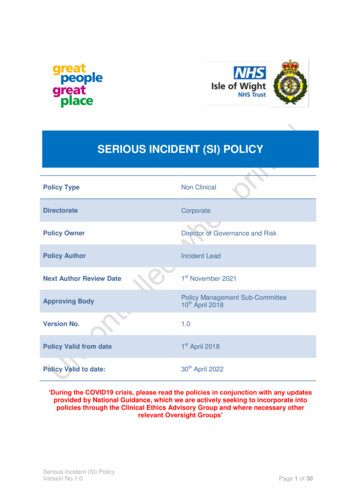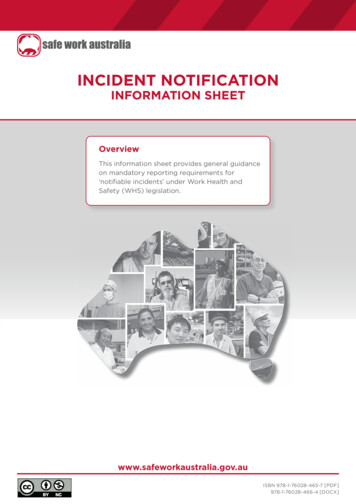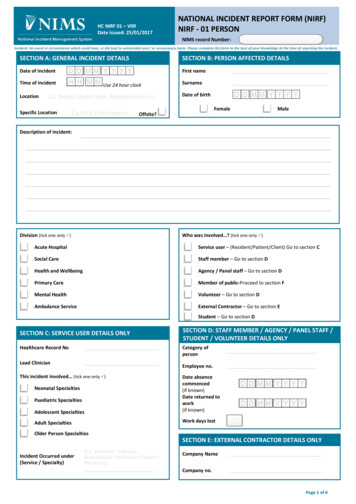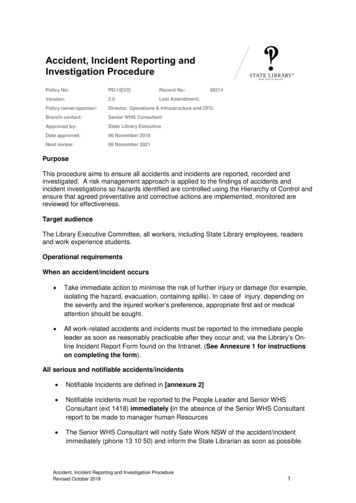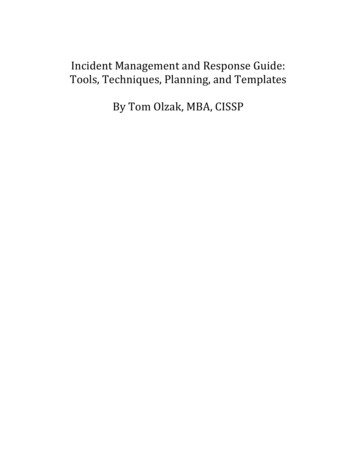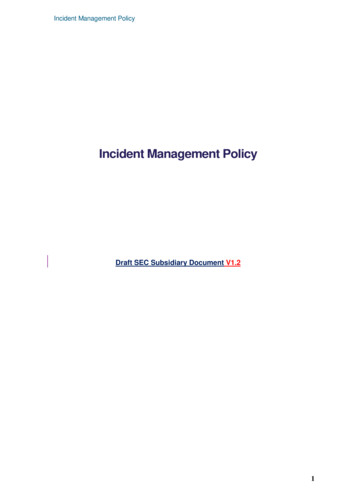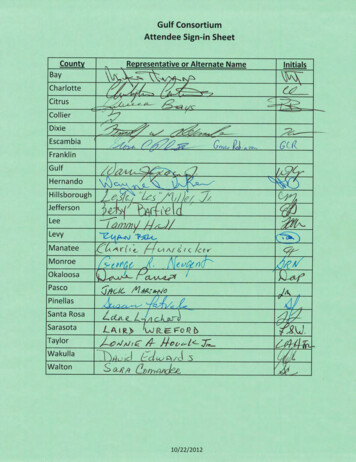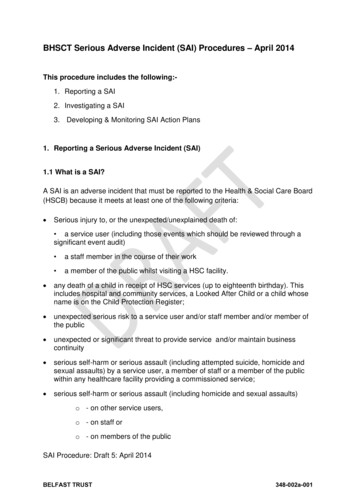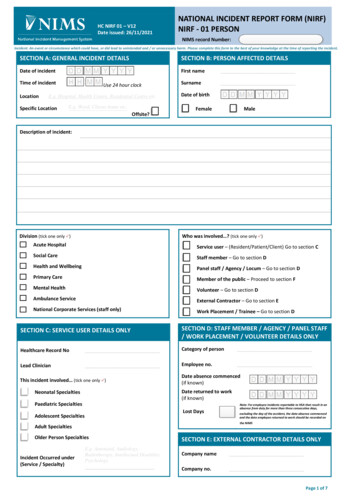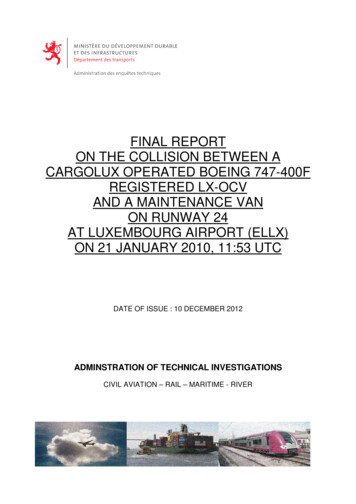
Transcription
FINAL REPORTON THE COLLISION BETWEEN ACARGOLUX OPERATED BOEING 747-400FREGISTERED LX-OCVAND A MAINTENANCE VANON RUNWAY 24AT LUXEMBOURG AIRPORT (ELLX)ON 21 JANUARY 2010, 11:53 UTCDATE OF ISSUE : 10 DECEMBER 2012ADMINSTRATION OF TECHNICAL INVESTIGATIONSCIVIL AVIATION – RAIL – MARITIME - RIVER
Ministry of Sustainable Development and InfrastructureDepartment of TransportAdministration of Technical InvestigationsReport N AET-2012/AC-01FINAL REPORTON THE COLLISION BETWEEN ACARGOLUX OPERATED BOEING 747-400FREGISTERED LX-OCVAND A MAINTENANCE VANON RUNWAY 24AT LUXEMBOURG AIRPORT (ELLX)ON 21 JANUARY 2010, 11:53 UTCAET – Administration des Enquêtes TechniquesB.P. 1388 L-1013 LuxembourgTél: 352 247 84404Fax: 352 26 47 89 75Email: info@aet.etat.luWeb : www.mt.public.lu/transports/AET2
FOREWORDIn accordance with Annex 13 to the Convention on International Civil Aviation,Regulation (EU) No 996/2010 of the European Parliament and of the Council andLuxembourg law dated 30 April 2008 on technical investigations in relation toaccidents and serious incidents which happened in the domains of civil aviation,maritime transport and railways, it is not the purpose of the aircraft accidentinvestigation to apportion blame or liability.The sole objective of the safety investigation and the Final Report is the prevention ofaccidents and incidents.Consequently, the use of this report for purposes other than accident prevention maylead to wrong interpretations.Note: All time indications are in Co-ordinated Universal Time (UTC) unless specifiedotherwise.3
CONTENTSGLOSSARY 8SYNOPSIS 101.FACTUAL INFORMATION 121.1History of flight 121.2Injuries to persons 131.3Damage to aircraft 131.4Other damage 141.5Personnel information 141.5.1Flight crew 141.5.2Aerodrome control tower 151.5.3ELE 23 maintenance crew 151.6Aircraft information 161.6.1Airframe 161.6.2Engines 161.6.3Additional aircraft information 161.71.7.1Meteorological information 17Forecast 171.7.1.1 Synoptic Situation 171.7.1.2 Weather Forecast 171.7.1.3 Terminal Area Forecast (TAF) 171.7.2Weather Observations 171.7.2.1 Meteorological Airport Report (METAR) 171.7.2.2 Runway Visual Range (RVR) Values 171.8Aids to navigation 181.8.1Aerodrome 181.8.2Aircraft 181.9Communications 181.9.1General context 181.9.2ELE 23 communication equipment 191.9.3ATC Recordings 201.9.3.1 Ground control frequency 121.900 MHz 201.9.3.2 Controller Working Position 2 (CWP2) 201.9.3.3 Tower frequency 118.100 MHz 221.10Aerodrome information 221.11Flight recorders 244
1.11.1QAR Data 241.11.1.11.11.2Relevant parameters 24CVR Recordings 241.12Wreckage and impact information 261.13Medical and pathological information 261.14Fire 261.15Survival aspects 261.16Tests and research 261.16.1Aerodrome control tower R/T equipment issues 261.16.1.1Tests and research by CNS Department 271.16.1.1.1ATC recordings 271.16.1.1.2Microphone on CWP2 271.16.1.1.3Aerodrome control tower R/T system 271.16.1.21.17Aerodrome Data Display (ADD) 28Organizational and management information 281.17.1Organisation of the Air Traffic Control Service 281.17.2Aerodrome control tower 291.17.2.1Tower layout 291.17.2.2Memorisation aids to mark an occupied RWY 301.17.2.3TWR control positions 321.17.2.3.1TWR controller 321.17.2.3.2TWR coordinator/assistant 321.17.2.4TWR control shift work 331.17.3ATC Procedures – MATS 331.17.4Procedure on Luxembourg Language Phraseology 401.17.5Low visibility procedures (LVP) 411.17.6Common practice for vehicles to access the manoeuvring area 411.17.7ICAO provisions on Air Traffic Services and Aerodromes 411.17.7.1ICAO Annex 11 – Air Traffic Services 421.17.7.2ICAO Annex 14 – Aerodromes; Volume 1 421.17.7.3AN/463)Manual on the Prevention of Runway Incursions (ICAO Doc 9870,421.17.8 European Action Plan for the Prevention of Runway Incursions(EAPPRI) 431.17.9Ground operations 441.17.9.1ELE Department 441.17.9.2Runway Centreline Lighting Problems 445
1.17.9.31.18Preventive maintenance work 45Additional information 451.18.1Statements of the TWR control staff 451.18.1.1TWR controller 451.18.1.2TWR coordinator/assistant 461.18.2 Advanced Surface Movement Guidance and Control System (ASMGCS) 471.18.3Corrective actions taken after the occurrence 471.18.3.1DAC Safety Orders 471.18.3.2ANA 481.18.3.2.1Amendments to MATS 481.18.3.2.2ELE Department 481.19Useful or effective investigation techniques 491.19.12.System Occurrence Analysis Method (SOAM) 49ANALYSIS 502.1Elements related directly to the event 502.1.1Standard phraseology procedures 502.1.2Ground traffic control and surveillance 512.1.2.1 ATC perspective 512.1.2.2 Flight crew perspective 522.1.3Aerodrome control tower 542.1.3.1 Runway management 542.1.3.2 Work procedures in low visibility operations 552.1.4Organisational aspects 572.1.4.1 Decision to carry out preventive maintenance work 572.1.4.2 Compliance to MATS 572.2Other safety relevant elements 582.2.1Memorisation techniques 582.2.2Situational awareness for ground operations during LVP 582.2.3Timely dissemination of information by CLX 793 592.2.4Confirmation bias 602.2.5Post-occurrence co-ordination issues 602.2.6Back-up communication means for ground operators 613.CONCLUSIONS 623.1Findings 623.2Causal and contributory factors 634.RECOMMENDATIONS 646
APPENDIX A – MATS Amendment 66APPENDIX B – SOAM Chart 677
SCAACAT IIICISMCLX 793CNSCTRCVRCWPDACDHDMEEASAELEELE VPAerodrome Data DisplayAdministration des Enquêtes Techniques – Safety InvestigationAuthorityAeronautical Information PublicationAssociation Luxembourgeoise des Pilotes de LigneAdministration de la Navigation Aérienne – ANSP in LuxembourgAir Navigation Service ProviderApproach control unitAdvanced Surface Movement Guidance and Control SystemAir Traffic ControlAir Traffic ControllerAir Traffic ManagementAir Traffic ServicesCivil Aviation AuthorityCategory III ApproachCritical Incident Stress ManagementCargolux flight nr 793 from Barcelona (LEBL) to Luxembourg(ELLX)Communication, Navigation and Surveillance Department of ANAControl AreaCockpit Voice RecorderController Work PositionDirection de l'Aviation Civile – Luxembourg CAADecision HeightDistance Measuring EquipmentEuropean Aviation and Safety AgencyElectricity Department of ANAMaintenance vehicle nr 23 from the Electricity DepartmentICAO Code for Luxembourg AirportFederal Aviation AdministrationFlight Data ProcessorFlight Data RecorderFlight LevelFirst OfficerForeign Object DebrisGround Movement ControlGlobal Positioning SystemInternational Civil Aviation OrganisationInstrument Landing SystemInertial Reference SystemKilohertzKnotsICAO Code for Barcelona AirportLow Visibility Procedures8
HLow Visibility OperationsManual of Air Traffic ServicesMegahertzNon-Directional BeaconNautical MileNational Supervisory AuthorityNational Transportation Safety BoardOfficial Journal of the European UnionOperations manual – Part AOperations DepartmentProcedures for Air Navigation Services – Air Traffic ManagementPilot FlyingPilot MonitoringPilot Not FlyingPush-to-talkQuick Access RecorderReference Datum HeightRate of climbRate of descendRadiotelephonyRunway Visual RangeRunwayICAO Standards and Recommended PracticesService Incendie et Sauvetage de l’Aéroport – Airport Fire andRescue ServiceSurface Movement RadarRunway ThresholdTerminal AreaAerodrome Control TowerICAO Code for Heydar Aliyev International Airport near Baku,AzerbaijanCoordinated Universal TimeICAO Code for Hong Kong International Airport9
SYNOPSISNotification of eventThe event has initially been notified as ‘accident’ to the NTSB, to EASA and to ICAOon the day of the occurrence. The initial classification was based on national lawwhich has a different definition of an ‘accident’ than ICAO or EU provisions. Shortlybefore publication, the occurrence has been reclassified by AET as a ‘seriousincident’ in accordance with prevailing ICAO Annex 13 and Regulation (EU) No996/2010 definitions. In fact, the aircraft damage was limited to a tire which had to bereplaced and which, as a non-structural part, does not fall within the scope ofsubstantial damages.Identification of investigating authorityThe authority responsible for the safety investigation is the ‘Administration desEnquêtes Techniques (AET)’, which is the permanent and independent investigationbody in Luxembourg. The NTSB has named an accredited representative and hasselected the FAA and Boeing as technical advisers. Cargolux nominated a ‘TechnicalPilot’ to participate as an adviser and the ‘Association Luxembourgeoise des Pilotesde Ligne (ALPL)’, a Luxembourg association representing the airline pilots, has beengranted participation in the investigation on their request and have delegated a FirstOfficer flying for Cargolux as a technical adviser.At a later stage, external ATC experts were asked to provide assistance in thedrafting of the final report.Organisation of safety investigationThe AET was contacted shortly after the occurrence and reached the aircraft onapron P7 approximately one hour later. During the inspection of the airplane, the onlydamage that could be found were several cuts, including side cuts, on tire no 12 onthe right hand body landing gear. Cargolux was instructed to quarantine the CVR andQAR data, as well as tire no 12 which had to be replaced due to the side cutsstemming from the collision with the van on the runway.Scope of the safety investigationIn accordance with Annex 13 provisions, the final report may cover all safety relevantaspects which have been identified during the investigation, even if they are notlinked directly to the main event. The investigation authority, after analysis ofavailable data, has identified safety issues which are not in direct relation to theoccurrence, but which will be addressed in the present report.Résumé of the circumstancesOn 21 January 2010, a Cargolux 747-400F was operating the scheduled freight flightCLX 793 from Barcelona to Luxembourg. On approach into Luxembourg, at 11:40:27UTC, CLX 793 received information from Luxembourg approach control that LowVisibility Procedures (LVP) were in operation. It should be noted that LuxembourgAirport is not equipped with Surface Movement Radar (SMR) or any other means ofground movement surveillance. CLX 793 continued a Cat III(b) approach to thethreshold of runway 24 where the PF briefly saw an object he believed to be a vehiclestanding on the runway in the touchdown zone. CLX 793 completed an uneventfulauto-landing at 11:53:51 UTC and after vacating the active runway, the crewinformed Luxembourg aerodrome control about a car on the runway. A short time10
before, the maintenance crew, carrying out preventive maintenance on the runwaycentreline lights, called the aerodrome control tower from a mobile phone and told theTWR coordinator/assistant that they had been working on the runway while anairplane was landing and that the aircraft damaged the roof of their van with thelanding gear.11
1. FACTUAL INFORMATION1.1 History of flightThe aircraft was operating a scheduled freight flight from Barcelona (LEBL), Spain toELLX-Luxembourg. The aircraft‘s actual departure time in Barcelona was 10:13. At11:40:27, CLX 793 contacted Luxembourg Approach (APP) for the first time and wasadvised by the approach controller that Low Visibility Procedures (LVP) were inoperation. At that time, the aircraft was inbound waypoint AKELU, passing FL 154.Fog prevailed at Luxembourg airport with a cloud base at 100 feet overcast and avisibility of 100 meters, temperature and dew point were at 1 C. According to thetower logbook, LVP’s were operational from 7:17 onwards.The aircraft was instructed to descend to FL 80 for an ILS approach on Runway 24.RVR readings were 350/275/375 meters. At 11:49:34 the approach controllerinstructed CLX 793 ‘turn left heading 270 to intercept, cleared ILS 24, reportestablished’. At 11:50:55, CLX 793 reported established on the localiser for Runway24 and was transferred to Tower on 118,1 MHz. RVR readings had decreased to350/250/350 meters.After passing the fix ‘ELU’ NDB at an altitude of 3000 ft (5.38 NM from THR 24), CLX793 contacted Luxembourg Tower (TWR) at 11:51:40 and reported established onthe ILS 24. Part of that radio call was blocked out by a call from Luxair 4883 on apronP1 requesting a taxi clearance. Tower received the fragments ‘Lux 93 establishedILS 24’ and, after clearing Luxair 4883 to taxi to the Cat III holding point runway 24,issued a landing clearance to CLX 793. At that time, CLX 793 was approximately 4.5NM from the runway. The wind was calm and RVR readings were still at 350/250/350meters.At 11:52:26 CLX 793 completed the landing checklist and at 11:53:46, reachingdecision height at 17 ft, the PF called out ‘landing’. During the flare, the airplaneimpacted a maintenance van ELE 23 positioned slightly to the right of the centrelineof runway 24 and about 340 meters from the threshold, with the front-end pointinginto the opposite direction (060 ). The roofline of the van was at a height of 2.54 m (8ft). The right hand body landing gear of the Boeing 747-400F impacted the roof ofELE 23 with tire nr 12 slightly below the roofline of the van on a backward sloped roofsection and rolled over it, damaging the roof on the whole length of the vehicle. Thevan’s lightbar, as well as its R/T antennas, were ripped off on impact. Themaintenance crew working on the centreline lights outside of ELE 23 ran off the sideof the runway as soon as they noticed an increasing noise from a landing aircraft.The aircraft landed safely at 11:53:51.After touchdown, at 11:53:59, the PF mentioned to the PM that there was a car in thetouchdown zone. The PM, monitoring the instruments during landing in accordancewith company procedures, didn’t notice it.The aircraft vacated RWY 24 at taxiway Echo and at 11:56:28, while taxiing to apronP7, the PF informed the TWR controller about a car in the touchdown zone. Thecontroller asked if there was a problem and the PF denied. The aircraft continued tothe parking position on apron P7 without further incident.12
Up to that point, there was no indication that the crew was aware of the airplane’scollision with the maintenance van which the PF saw during landing.Damage to the aircraft was limited to tire nr 12 on the right land body landing gear,which sustained several cuts including side cuts and which had to be replaced.1.2 Injuries to sOthers2121.3 Damage to aircraftDamage to the aircraft was limited to cuts on tire nr 12 located on the right hand bodylanding gear, sustained from impact with the van’s lightbar which was ripped off. Thetire had to be replaced. It is unlikely that the damage to the tire could stem from aprevious flight considering that the tires nr 11 and 12 had been replaced shortlybefore in Hong Kong and that the Barcelona-Luxembourg leg was the 3rd flight sincethe replacement.Picture 1: Tire nr 12 (Source AET)13
1.4 Other damageThe roof of the maintenance van was damaged on the whole length of the vehicle.The light-bar and the R/T antennas were ripped off on impact.Picture 2: Van ‘ELE23’ (Source AET)1.5 Personnel information1.5.1 Flight crewFunctionAgeNationalityLicense typeTotal flight hoursHours on typeLast 3 daysLast 28 daysLast 30 daysDay of eventLast proficiency checkLast line checkLast medical checkLicense valid untilType rating valid untilCaptainFirst 72713:31 hrs13:31 hrs13:31 hrs30:41 hrs13:31 hrs30:41 hrs7:24 hrs7:24 hrs27.08.2009 11.11.200915.07.2009 09.01.201002.09.2009 09.01.201031.03.2014 25.06.201031.03.2010 30.06.201014
1.5.2 Aerodrome control towerPositionAgeNationalityQualifications (TWR controlpositons as defined in MATS)Last medical checkExperience sinceHrs on duty before occurrenceHrs off duty before shift startLast shift before day ofoccurrenceHrs on duty during last shiftbefore occurrenceCWP 1TWR controllerCWP WR controller &TWR controller &TWRTWRassistant/coordinator 419.01.20011:24 hrs1:24 hrs19 hrs19 hrs20.01.201020.01.2010MorningMorning4:30 hrs4:30 hrsThe TWR controller and the TWR coordinator/assistant both followed anemergency/refresher training course provided by DFS (Deutsche Flugsicherung)shortly before the occurrence (course id TWR-E09 on 16-19 November 2009 for thecoordinator/assistant and TWR-E11 on 14-17 December 2009 for the TWRcontroller). The course was developed to comply with the provisions of the EuropeanSafety Regulatory Requirements ESARR5.The content of the emergency/refresher training course was the following:-Refreshing existing theoretical knowledgeBuilding situational awarenessBasic procedures for emergencies at the airportIncreasing awareness for cockpit proceedingsPractical application of procedures and the use of checklistsLearning appropriate control and co-ordination proceduresLearning appropriate standards according to the ASSIST principle1.5.3 ELE 23 maintenance crewPositionAgeNationalityExperience sinceHrs on duty before occurrenceOperator 1Electrician20Luxembourg200804:2415Operator 2Assistant45Luxembourg199304:24
1.6 Aircraft information1.6.1 AirframeManufacturerAircraft designationSerial NrYear of manufactureAirworthiness certificateDate of issueDate of expiry (ARC)Flight hoursCyclesThe 55967105121.6.2 EnginesManufacturer:Rolls-RoyceNumber and type: 4 x RB211-524H2-T-19/151.6.3 Additional aircraft informationCargolux summary regarding an incident at Hong Kong International Airport (VHHH)on 11 January 2010:‘ The Boeing 747-400F aircraft, LX-OCV, call sign, ‘Cargolux 759’, (CV759) wasoperating a scheduled flight. The flight was planned to depart Hong KongInternational Airport on the 11th of January 2010 at 15:30 UTC with destination Baku,Azerbaijan.After being pushed back from parking position ‘C22’, the aircraft started taxi under itsown power via taxiway ‘L3’ and ‘K’ to holding position for runway ‘07R’.During takeoff, the crew felt a minor ‘rolling/swaying’ followed by subtle vibration. Asa precautionary measure, the crew decided to abort the take off at approximately 85knots.A fire on the right hand body landing gear (RH BLG) was extinguished by the firebrigade with water. The aircraft came to a stop on the runway. No events werereported by the crew until the take-off was aborted, due to indication of airframevibration.No persons were injured during this incident.’The wheel assemblies nr 11 and nr 12 were destroyed and some gear doors andfairings were damaged. The complete right-hand side body landing gear wassubsequently replaced in Hong Kong and the airplane was back in service on 20January 2010, one day before the occurrence at Luxembourg Airport. The airplane’sitinerary departing Hong Kong was Baku (UBBB) – Barcelona (LEBL) – Luxembourg(ELLX) and took a total of 15:38 flight hours. The crew of CLX 793 flew the legs Baku- Barcelona - Luxembourg, totalling 7:24 hours on the day of the occurrence.16
1.7 Meteorological information1.7.1 Forecast1.7.1.1 Synoptic SituationA weak pressure gradient determined the weather over Luxembourg. The frontalsystem of weak activity situated over Germany, associated to the depression over theMediterranean, was forecasted to dissipate during the day.1.7.1.2 Weather ForecastOvercast weather with light snow showers in the morning, followed by a mistyovercast sky and possible freezing fog the next morning.1.7.1.3 Terminal Area Forecast (TAF)TAF (2106/2212)12004KT 2000 BR SCT001 BKN004BECMG 2106/2108 0300 FZFG BKN001BECMG 2108/2110 3000 BR BKN003 BKN008BECMG 2110/2112 18003KT 6000 BKN008 BKN012BECMG 2112/2114 20002KT 8000 BKN012BECMG 2203/2205 09002KT 0500 FZFG BKN002BECMG 2208/2210 3000 BR BKN005 The highlighted TAF for the date of occurrence, from 10:00 to 12:00, read as follows:Surface wind from 180 at 3 knots, visibility 6 km, broken cloud layer at 800 feet,broken cloud layer at 1200 feet.1.7.2 Weather Observations1.7.2.1 Meteorological Airport Report (METAR)ELLX 211120Z VRB03KT 0150 R24/0375N FG OVC001 01/01 Q1020 NOSIGELLX 211150Z 12003KT 0100 R24/0350N FG OVC001 01/01 Q1020 NOSIGELLX 211220Z VRB03KT 0100 R24/0275N FG OVC001 01/01 Q1020 NOSIGELLX 211250Z 13002KT 0100 R24/0250N FG OVC001 01/01 Q1019 NOSIGThe highlighted METAR closest to the time of occurrence read as follows:Issued at 11:50z, wind from 180 at 3 knots, visibi lity 100 m, visual range of 350 m atthreshold runway 24, fog, overcast sky at 100 feet, temperature 1 , dew point 1 ,QNH 1020, no significant change forecasted.1.7.2.2 Runway Visual Range (RVR) ValuesThe Manual of Air Traffic Services (MATS) defines the runway visual range as “therange over which the pilot of an aircraft on the centre line of a runway can see therunway surface markings or the lights delineating the runway or identifying its centreline”. On the day of the occurrence, relevant RVR readings for runway 24 are shownhereafter:17
Time (z) Touchdown (m)113235011333501154350RUNWAY 24Midpoint (m)Rollout (m)325450325450225325ObservationELE 23 entering runway 24Time of occurrence1.8 Aids to navigation1.8.1 AerodromeThe ILS CAT III radio navigation and landing aids available for runway 24 are:- A non-directional beacon NDB (ELU/368.5 kHz) situated 5.38 NM from thethreshold of runway 24;- a VHF localizer (ILW/110.7 MHz) situated 2.31 NM from the threshold ofrunway 24;- a UHF glide path transmitter (330.2 MHz) with a glide slope angle of 3 and anILS reference datum height (RDH) of 52 feet;- a distance measuring equipment DME (ILW/channel 44X) collocated with theglide path transmitter.1.8.2 AircraftCLX 793 performed a Cat III(b) auto-land approach into ELLX. Passing 2500 ft,“Land 3” status became active, with all 3 autopilot channels engaged and workingnormally. The aircraft was “Fail Operational”, meaning that after the failure of 1 out ofthe 3 channels, the remaining part of the automatic system would still be able to carryout the approach, flare and landing.The decision height (DH) for Cat III approaches is 17 ft and the minimum RVR for CatIIIb approaches into ELLX (RWY 24) is 125 meters. OM-A defines the task sharingduring Cat II/III approaches and states that the Commander shall be the PF forapproach and landing or go-around, with the F/O acting as PM. The companyprocedure for final approach is the following:- At 100 feet above DH, the Commander goes head-up and concentrates onexpected outside visual cues, while the PNF (PM) stays head-down andmonitors the auto-flight indications;- When passing the DH and if visual reference is established, the PF calls out“Landing” and monitors the approach and landing by visual cues, while the PMstays head-down to monitor the landing roll;- When passing the DH and if visual reference is not established, the PF callsout “Go-around”, starts the go-around and resumes the instrument scan, whilethe F/O stays head-down and monitors the go-around.1.9 Communications1.9.1 General contextAt the time of the event, CLX 793 was in contact with Luxembourg aerodrome controltower on 118.10 MHz. The communications between airplane and tower wererecorded on the airplane’s CVR and on the ATC recording equipment. Both18
recordings were made available to the investigation authority and transcripts of theATC recording were provided by ANA, the national ANSP.The communication between Luxembourg aerodrome control tower and themaintenance crew was carried out on ground control frequency 121.90 MHz and wasrecorded on the ATC system. The investigation authority received an audio copy anda transcript of the ground communication from ANA. Phone conversations from thecontroller work positions were also recorded and made available to the investigationauthority.It should be noted that ground control frequency 121.90 MHz is not published in theAIP or on the navigation charts.1.9.2 ELE 23 communication equipmentThe radiotelephony (R/T) equipment available to the ELE 23 maintenance crew wasa built-in VHF transceiver connected to an external loudspeaker located near thevan’s sliding door, enabling the ELE crew to maintain a listening watch oncommunications with TWR while working outside. Furthermore, the maintenancecrew was equipped with a mobile phone and was provided with a list of importanttelephone numbers, including the one for the TWR unit, enabling them to contactTWR if needed (e.g. R/T equipment failure). The mobile phone number of ELE 23maintenance crew was however not known to the TWR unit.LoudspeakerMobile PhoneVHF TransceiverPicture 3: ‘ELE23’ R/T Equipment (Source ANA)A handheld VHF transceiver was not part of the R/T equipment provided to ELE 23as in some parts of the manoeuvring area, it was not possible with this type ofequipment to maintain a communication link with TWR.19
1.9.3 ATC RecordingsRelevant ATC related communications not recorded on the CVR or presented inparagraph 1.11.2 - CVR Recordings are laid down hereafter.Communications on ground control frequency 121.9 MHz and over the phone at theController Working Position 2 (CWP2) were mainly in Luxembourgish language andhave been translated into English by AET for the purpose of the report.1.9.3.1 Ground control frequency 121.900 MHzAt 11:33:15, ELE 23 called Luxembourg Tower on ground control frequency 121.9MHz and asked for clearance to drive from apron P3 onto the runway and taxiways.ELE 23 was in direct contact with the TWR Assistant/Coordinator on that frequency.At 11:33:23, ELE 23 was cleared to drive directly onto the runway and acknowledgedthe instruction.No other communication was recorded on ground control frequency until after theoccurrence.At 11:55:21, a loud noise was heard for about one second.At 11:55:26, more than a minute after the collision, ELE 23 called Tower.During a telephone conversation, the electrician from ELE 23 asked the TWRcoordinator/assistant to call ELE 23 on ground fre
Cargolux nominated a 'Technical Pilot' to participate as an adviser and the 'Association Luxembourgeoise des Pilotes de Ligne (ALPL)', a Luxembourg association representing the airline pilots, has been granted participation in the investigation on their request and have delegated a First Officer flying for Cargolux as a technical adviser.
